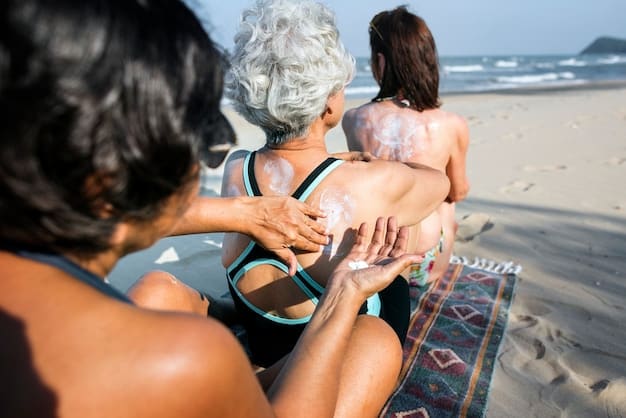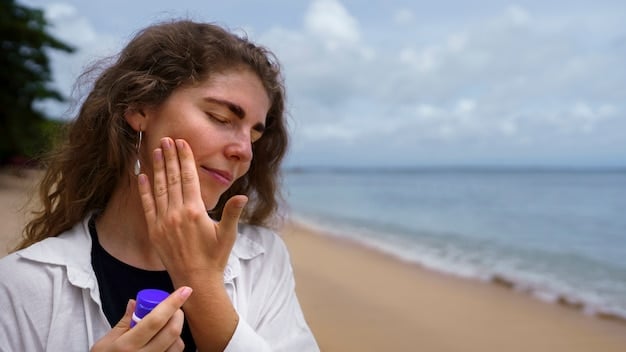Sunscreen Guide: Choosing Right SPF for Your Skin Type This Summer

Navigating the array of sunscreen options requires understanding your skin type and sun exposure, as the right SPF offers optimal protection against harmful UV rays while preventing sunburn and premature aging.
As summer beckons with its promise of sunny days and outdoor adventures, the importance of adequate sun protection becomes paramount. Our Sunscreen Guide: Choosing the Right SPF for Your Skin Type This Summer offers essential insights to ensure your skin stays safeguarded from harmful UV radiation, allowing you to embrace the season safely and confidently.
Understanding SPF and UV Radiation
Before diving into specific recommendations, it’s crucial to grasp what SPF truly stands for and how UV radiation impacts our skin. SPF, or Sun Protection Factor, measures how well a sunscreen protects against UVB rays, which are the primary cause of sunburn and contribute significantly to skin cancer.
However, it’s not just about UVB. UVA rays also play a considerable role in skin aging, including wrinkles, fine lines, and age spots, and contribute to skin cancer. Therefore, choosing a broad-spectrum sunscreen that offers protection against both UVA and UVB is vital for comprehensive defense.
The Science Behind SPF
The number next to SPF indicates the approximate time you can stay in the sun without burning, compared to how long it would take without any protection. For example, SPF 30 means you can stay in the sun roughly 30 times longer before burning. However, this is an ideal scenario and real-world factors like sweating, swimming, and improper application can reduce its effectiveness.
It’s a common misconception that higher SPF numbers offer proportionally greater protection. While SPF 30 blocks about 97% of UVB rays, SPF 50 blocks about 98%, and SPF 100 blocks about 99%. The difference in protection becomes minimal, yet higher SPFs often lead to a false sense of security, encouraging longer sun exposure without reapplication.
Key UV Facts:
- ☀️ UV Index: Pay attention to the daily UV Index to gauge the sun’s intensity.
- ⏰ Peak Hours: Avoid prolonged sun exposure between 10 AM and 4 PM when UV rays are strongest.
- 💧 Water Resistance: Opt for water-resistant formulas if swimming or sweating.
- ☁️ Cloud Cover: UV rays can penetrate clouds, so protection is always necessary.
Understanding the nuances of SPF and UV radiation empowers you to make informed decisions about your sun protection strategy. It’s not simply about slathering on any sunscreen; it’s about choosing the right tool for the job based on scientific understanding and personal needs.
Identifying Your Skin Type and Sun Sensitivity
Selecting the appropriate sunscreen begins with a thorough understanding of your own skin. Skin types fall into various categories, each with unique characteristics and sensitivities to sunlight. Recognizing where your skin fits into this spectrum is the first step toward effective sun protection this summer.
Generally, skin types are categorized using the Fitzpatrick Scale, which classifies skin based on its response to sun exposure. This scale considers factors like natural hair color, eye color, and how easily skin burns or tans. It ranges from Type I (very fair, always burns, never tans) to Type VI (darkest brown, never burns, always tans deeply).
Fair Skin (Fitzpatrick Types I & II)
Individuals with very fair skin, often with light eyes and hair (red, blonde), are highly susceptible to sunburn and have a higher risk of developing skin cancer. Their skin produces less melanin, the pigment that provides natural protection against UV radiation. For these skin types, a vigilant approach to sun protection is non-negotiable.
For those with fair skin, a higher SPF is generally recommended, not because it offers dramatically more protection, but because it provides a slightly longer window of protection against UVB rays, offering a small buffer against accidental overexposure. Consistent reapplication is more critical than aiming for an ultra-high SPF.
Considerations for Fair Skin:
- 🔥 High SPF: Opt for SPF 50 or higher for primary protection.
- 🛡️ Broad-Spectrum: Ensure it protects against both UVA and UVB rays.
- 🚫 Reapplication: Reapply every two hours, or more often if swimming or sweating.
- 👗 Protective Clothing: Supplement with hats, sunglasses, and UPF clothing.
Medium Skin (Fitzpatrick Types III & IV)
People with medium skin tones tend to tan easily but can still burn, especially after prolonged exposure without protection. This category includes a broad range of complexions, from light brown to olive. While they have more melanin than fair-skinned individuals, it’s not enough to fully shield them from UV damage.

For these skin types, a broad-spectrum sunscreen with an SPF of 30 or higher is typically sufficient for daily use and moderate sun exposure. However, during intense sun exposure, such as at the beach or during outdoor sports, an SPF 50 can offer an added layer of security.
The key here is balance and awareness. While medium skin types may not burn as quickly, accumulated sun damage can still lead to premature aging and increased risk of skin cancer. Therefore, consistent application and reapplication are just as important as for fairer skin types.
Darker Skin (Fitzpatrick Types V & VI)
Contrary to popular belief, individuals with darker skin tones are also susceptible to sun damage and skin cancer, although their risk of sunburn is lower due to higher melanin content. Sunscreen is still essential for these individuals to prevent hyperpigmentation, accelerate photoaging, and reduce the risk of skin cancer.
Melanin offers a natural SPF of about 7-15, but it does not block all UV radiation. Darker skin tones are more prone to issues like post-inflammatory hyperpigmentation (dark spots) which can be triggered or worsened by sun exposure. Melanoma can also manifest differently and is often diagnosed at later stages in darker skin, making prevention vital.
For darker skin types, a broad-spectrum sunscreen with at least an SPF of 30 is recommended for daily use. If there’s a history of sun sensitivity or prolonged exposure is anticipated, an SPF 50 can provide additional reassurance. The texture and finish of the sunscreen are often a concern for darker skin tones, as many leave a white cast. Mineral sunscreens formulated with microfine zinc oxide or tinted formulas can address this issue.
Regardless of skin type, a proactive approach to sun protection is crucial. Understanding your skin’s unique response to the sun allows for a personalized and effective strategy to keep it healthy and protected throughout the summer and beyond.
Choosing Between Mineral and Chemical Sunscreens
The market offers two primary types of sunscreens: mineral (physical) and chemical. Each works differently to protect your skin, and understanding these mechanisms is key to selecting the one that best suits your preferences and skin needs.
Mineral sunscreens often contain zinc oxide and/or titanium dioxide. These active ingredients sit on the skin’s surface, forming a physical barrier that deflects and scatters UV rays away from the skin, much like a shield. They start working immediately upon application.
Chemical sunscreens, on the other hand, contain organic compounds like oxybenzone, avobenzone, octinoxate, and octisalate. These ingredients absorb UV radiation, convert it into heat, and then release it from the skin. Chemical sunscreens need about 15-20 minutes to be absorbed into the skin before they become effective.
The Advantages of Mineral Sunscreens
Mineral sunscreens are generally preferred by individuals with sensitive skin, babies, and those prone to acne because their active ingredients are less likely to cause irritation. They are often considered “reef-safe” when formulated without nanoparticles, making them a more environmentally conscious choice for beachgoers concerned about marine ecosystems.
A common drawback has been the tendency to leave a white cast, particularly on darker skin tones. However, formulators have made significant advancements, and many modern mineral sunscreens now come in tinted versions or with micronized particles that blend more seamlessly into the skin.
Benefits of Mineral Sunscreen:
- 🍃 Gentle: Ideal for sensitive and acne-prone skin.
- 🐠 Reef-Safe: Often formulated without harmful chemicals for marine life.
- ⏳ Instant Protection: Effective immediately upon application.
- 👶 Kid-Friendly: Recommended for children and infants.
The Advantages of Chemical Sunscreens
Chemical sunscreens typically offer a more lightweight texture and blend easily into the skin, making them cosmetically elegant and appealing for daily wear, especially under makeup. They are often favored by people who dislike the feel or appearance of thicker, mineral-based formulas.
However, some concerns have been raised about certain chemical filters, such as oxybenzone, regarding potential endocrine disruption and environmental impact. While regulatory bodies generally deem these ingredients safe for human use at approved concentrations, some individuals prefer to avoid them due to personal concerns or sensitivities.
Choosing between mineral and chemical sunscreens often comes down to personal preference, skin sensitivity, and environmental considerations. Many individuals opt for a blend, using mineral formulas for daily protection and chemical ones for specific activities like sports due to their lightweight feel.
Understanding Broad-Spectrum Protection (UVA & UVB)
When selecting a sunscreen, the term “broad-spectrum” is as important as the SPF number. It signifies that the product provides protection against both types of harmful ultraviolet (UV) radiation: UVA and UVB rays. Neglecting either type of protection leaves your skin vulnerable to significant damage.
UVB rays are traditionally associated with sunburn and are the primary cause of most skin cancers. The SPF rating on sunscreen specifically measures protection against UVB. However, UVA rays penetrate deeper into the skin and are largely responsible for photoaging (wrinkles, fine lines, age spots) and also contribute to skin cancer.
The Dual Threat of UV Radiation
Think of it this way: if UVB rays are the fast-acting, visible damage (sunburn), UVA rays are the slow, insidious damage that accumulates over time, leading to long-term skin health issues. A sunscreen that only protects against UVB would leave your skin susceptible to premature aging and the silent progression of cellular damage from UVA exposure.
This is why regulatory bodies and dermatologists strongly advocate for broad-spectrum protection. In the United States, for a sunscreen to be labeled “broad-spectrum,” it must pass specific tests demonstrating its ability to protect against both UVA and UVB rays in proportion to its SPF value.
Importance of Broad-Spectrum:
- aging: Prevents premature aging signs like wrinkles and sun spots caused by UVA.
- 🛡️ Comprehensive cancer prevention: Reduces risk of all types of skin cancer, not just those linked to UVB.
- 💡 Full protection: Ensures skin is shielded from the entire UV spectrum.
- 🌞 Daily necessity: UVA rays are present year-round, even on cloudy days, making broad-spectrum a daily requirement.
Without broad-spectrum protection, you might avoid a painful sunburn but still incur significant cellular damage that contributes to photoaging and increases your risk of skin cancer in the long run. Always check the label to ensure your chosen sunscreen clearly states “broad-spectrum.”
SPF for Different Activities and Scenarios
The ideal SPF isn’t a one-size-fits-all number. Your choice should adapt to your planned activities, the intensity of sun exposure, and environmental factors. A day at the office typically requires less robust protection than a full day at the beach or hiking in the mountains.
For everyday use, particularly if you spend most of your time indoors with minimal sun exposure (e.g., commuting to and from work), a broad-spectrum SPF 30 is generally sufficient. Many daily moisturizers and cosmetics now incorporate SPF 30, making it easier to integrate sun protection into your routine.
High-Exposure Scenarios: Beach, Sports, and High Altitudes
When you anticipate prolonged or intense sun exposure, such as a day at the beach, participating in outdoor sports, or spending time at high altitudes, it’s prudent to increase your SPF to 50 or higher. In these situations, several factors amplify UV radiation:
Situational SPF Needs:
- 🏖️ Beach/Water Activities: Water reflects UV rays, intensifying exposure. Use water-resistant SPF 50+.
- 🏃♀️ Outdoor Sports: Increased sweating requires very water-resistant SPF 50+ and frequent reapplication.
- ⛰️ High Altitudes: UV radiation increases by about 10% for every 1,000 meters in elevation. SPF 50+ is essential.
- ❄️ Snow/Ice: Snow reflects up to 80% of UV rays. Use SPF 50+ on exposed skin, even in winter.
Remember that “water-resistant” doesn’t mean “waterproof.” Sunscreens are typically labeled to indicate how long they remain effective in water (e.g., 40 minutes or 80 minutes). Reapplication after swimming or excessive sweating is crucial to maintain protection.

Even on cloudy days, up to 80% of the sun’s UV rays can penetrate clouds. Therefore, daily sunscreen application is important regardless of the weather forecast. Consider also using other forms of sun protection, such as wide-brimmed hats, UV-protective clothing, and sunglasses, especially during peak sun hours.
Application Techniques and Reapplication Tips
Even the highest SPF sunscreen won’t protect you if not applied correctly. Proper application and consistent reapplication are as critical as choosing the right product. Many people underestimate the amount of sunscreen needed or forget to reapply, significantly reducing its effectiveness.
As a general rule, use about an ounce (a shot glass full) for your entire body. For your face alone, a nickel-sized dollop is usually sufficient. Apply sunscreen to all areas of skin exposed to the sun, taking care to cover often-missed spots like the ears, neck, top of the feet, and part line of your hair (or wear a hat).
Maximizing Sunscreen Effectiveness
Apply sunscreen at least 15-20 minutes before sun exposure to allow it to fully absorb and form a protective barrier, especially for chemical sunscreens. This is particularly important before heading outdoors or jumping into water.
Reapplication is arguably the most overlooked aspect of sunscreen use. The general recommendation is to reapply at least every two hours, regardless of the SPF. However, this frequency should increase if you are swimming, sweating profusely, or toweling off.
Reapplication Best Practices:
- ⏲️ Every 2 Hours: Standard reapplication frequency for continuous protection.
- 🏊 After Water Exposure: Immediately reapply after swimming or excessive sweating.
- 🧖 Towel Drying: Sunscreen often rubs off when drying with a towel, necessitating reapplication.
- 🧴 Even Coverage: Ensure all exposed skin is covered evenly each time.
Consider using different forms for reapplication based on convenience. Sprays can be quick for body application, but ensure you spray enough to get adequate coverage and rub it in. Sticks are excellent for facial reapplication or for sensitive areas like around the eyes.
Remember, sunscreen is just one part of a comprehensive sun protection strategy. Combining it with seeking shade, wearing protective clothing, and avoiding peak sun hours will significantly enhance your defense against the sun’s harmful rays, ensuring a safer and more enjoyable summer experience.
Beyond Sunscreen: A Holistic Approach to Sun Safety
While choosing the right SPF and applying it diligently form the cornerstone of sun protection, a truly effective strategy extends beyond just sunscreen. A holistic approach to sun safety involves incorporating several protective measures, creating layers of defense against harmful UV radiation.
Relying solely on sunscreen can lead to a false sense of security, encouraging longer sun exposure without considering other forms of protection. UV radiation can cause damage even on cloudy days, during cooler temperatures, and in shaded areas, making constant vigilance necessary.
Protective Clothing and Accessories
One of the most effective ways to protect your skin is to cover it. Clothing acts as a physical barrier against UV rays. Look for garments labeled with a UPF (Ultraviolet Protection Factor) rating, which indicates how much UV radiation a fabric allows to reach your skin. A UPF of 30 or higher is considered good.
Wide-brimmed hats offer excellent protection for your face, ears, and neck—areas often overlooked when applying sunscreen. Sunglasses that block 99-100% of both UVA and UVB rays are crucial for protecting your eyes from cataracts and other sun-related eye conditions.
Elements of Holistic Sun Safety:
- 👒 Wide-Brimmed Hats: Protect face, ears, and neck.
- 🕶️ UV-Blocking Sunglasses: Safeguard eyes from UV-related damage.
- 👕 UPF Clothing: Offers measurable UV protection far superior to regular fabrics.
- 🌳 Seek Shade: Reduce direct sun exposure, especially during peak hours.
Seeking Shade and Timing Sun Exposure
The simplest and most effective way to reduce sun exposure is to seek shade, especially during the peak hours of 10 AM to 4 PM when the sun’s UV rays are strongest. Plan your outdoor activities for earlier mornings or late afternoons when the sun is less intense.
Utilize natural shade from trees or structures, or carry a portable umbrella for personal shade at the beach or park. Remember that even in the shade, reflective surfaces like sand, water, and snow can bounce UV rays onto your skin, so supplementary protection is still necessary.
Furthermore, be mindful of reflective surfaces in your environment. Water can reflect up to 10% of UV radiation, sand up to 25%, and snow up to 80%. This means you can still get a sunburn even if you’re under an umbrella or wearing a hat if you are near these surfaces.
By combining strategic sunscreen use with protective clothing, seeking shade, and being smart about when you expose yourself to the sun, you can significantly reduce your risk of sun damage, ensuring healthier skin and a safer summer experience. A holistic approach is truly the best defense.
| Key Point | Brief Description |
|---|---|
| 🧴 Choosing SPF | Match SPF to skin type (30+ for most, 50+ for fair/intense sun). |
| 🔬 Mineral vs. Chemical | Mineral (zinc/titanium) for sensitive skin; Chemical for lightweight feel. |
| ☀️ Broad-Spectrum | Essential for protection against both UVA (aging) and UVB (burning) rays. |
| 🔁 Reapplication Key | Reapply every two hours, or after swimming/sweating, for continuous defense. |
Frequently Asked Questions About Sunscreen
SPF stands for Sun Protection Factor, signaling how long it would take for UVB rays to redden skin when using sunscreen compared to how long it would take without any. For example, SPF 30 means it takes 30 times longer for your skin to burn. It primarily measures protection against UVB rays, which cause sunburn.
Yes, absolutely. Up to 80% of the sun’s UV rays can penetrate clouds. This means you are still at risk of sun damage, including sunburn and premature aging, even on overcast days. Consistent daily sunscreen application is vital, regardless of weather conditions, for year-round protection.
For optimal protection, sunscreen should be reapplied at least every two hours. If you are swimming, sweating heavily, or towel-drying, reapply more frequently, typically immediately after these activities. Even water-resistant sunscreens lose their effectiveness over time and with exposure to water or sweat.
While higher SPFs offer slightly more protection, the difference is often marginal. For instance, SPF 30 blocks 97% of UVB rays, while SPF 50 blocks 98%. The critical factor is applying enough sunscreen and reapplying often. Over-reliance on a very high SPF can lead to a false sense of security and increased sun exposure.
Yes, unequivocally. While darker skin has more melanin, offering some natural protection, it is still susceptible to UV damage. Sunscreen is crucial for preventing photoaging (dark spots, wrinkles) and reducing the risk of skin cancer, which can often be diagnosed later in individuals with darker skin due to less obvious signs.
Conclusion
Navigating the world of sunscreens can seem daunting, but armed with the right knowledge, you can make informed choices to protect your skin effectively this summer. Understanding SPF, identifying your skin type, distinguishing between mineral and chemical formulas, and adopting broad-spectrum protection are all critical steps. Remember that sunscreen is just one part of a comprehensive sun safety strategy, which also includes seeking shade, wearing protective clothing, and reapplying diligently. By integrating these practices, you can enjoy the sun responsibly, safeguarding your skin’s health for years to come.





